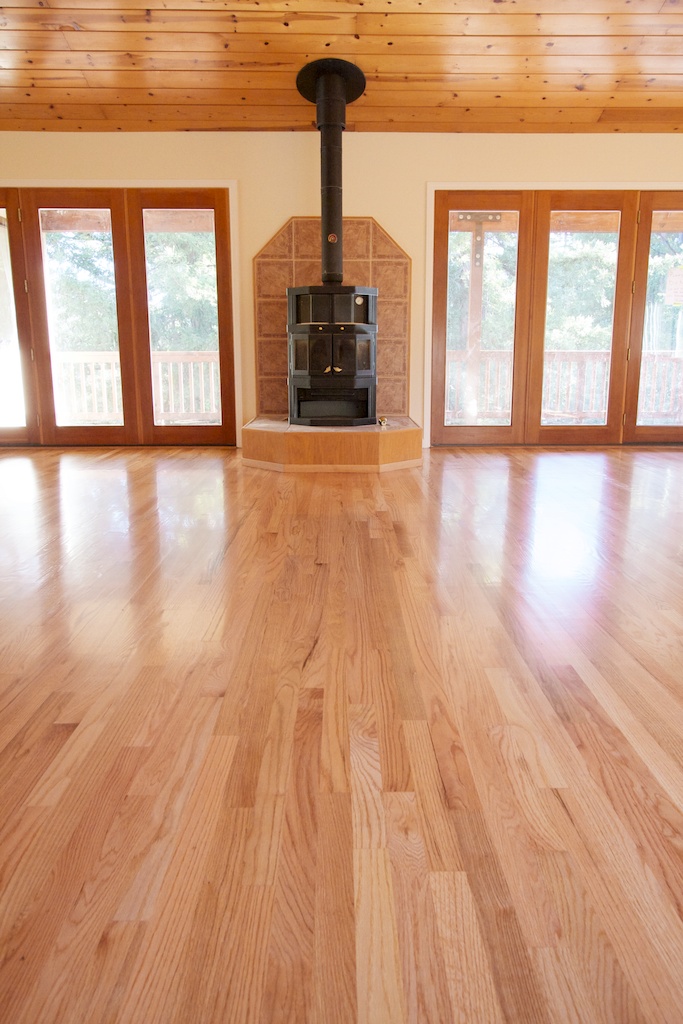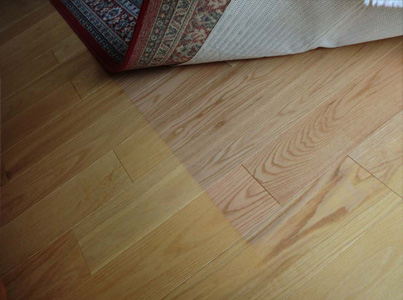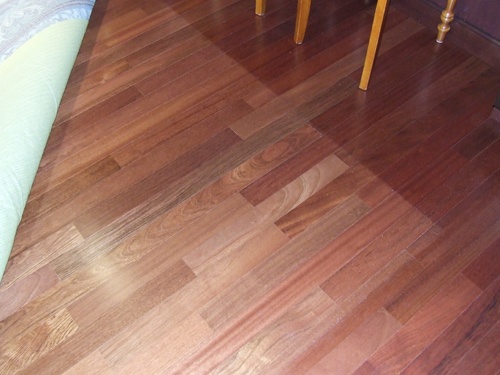Sun Damaged Hardwood Floors
Who doesn’t love a light, bright and airy home?
I know I do, especially in the warmer months when the windows can be opened to feel that warm cross-breeze throughout the house. We tend to think more about this during the cold, dark winter months. How nice it would be to have the sunlight beaming in through the open windows, warming the house up just enough. But have you ever given any thought to what those glorious beaming rays of sunlight might be doing to your hardwood floors?
Not many people realize that prolonged sun exposure on your natural hardwood floor has the potential to cause sun damage. Actually, damage is a pretty strong word. The sun doesn’t necessarily “damage” your hardwood. It will however discolor the flooring faster than normal, usually causing the floor color to lighten or fade. The effect that sunlight has on your hardwood floor all depend on what species it is. Some species of hardwood darken in color with prolonged sun exposure while others will lighten. One of the most common and noticeable examples of hardwood floor discoloration is directly underneath an area rug. You will notice this considerably if you’ve had an area rug down for a substantial amount of time only to remove it to find the color difference between where the area rug was, and where the hardwood has been exposed to natural light.
So you’re probably wondering; “How can the sun damage my floors?” Again, I don’t like to use the word “damage”, but rather “discolor.” The answer is really quite scientific. The reaction that natural wood has from the ultra violet rays in sunlight is called “photochemical oxidation”. Wood is naturally made up of atoms, which are surrounded by a field of electrons. The electrons, which work in pairs, are what react to UV light. What happens is, once the electrons are exposed to UV light, one of the pair will fly away, leaving what is known as a “free radical,” or sick atom. Once a free radical, the process of photochemical oxidation begins, eventually leading up to complete oxidation. Oxidation causes various properties of the natural wood to change, one property being its color. Since wood species are chemically different, the changes due to oxidation are different. Some oxidize very quickly, some very slowly. Certain species of hardwood actually look richer and bolder once oxidation has taken place, while others may look dull, in comparison.
Below is a breakdown of some key points you want to be savvy about when you have hardwood flooring in your home:
CAUSES OF HARDWOOD DISCOLORATION
- Prolonged exposure to Ultraviolet Sun Rays;
- Heat causes chemical reactions which also affect the woods color;
- Moisture-not only direct moisture like a mop and bucket, but humidity levels in your home will affect the appearance of the hardwood as well.
- Oxidation- this is something that happens to all hardwoods naturally, but exposure to UV rays cause the process to occur more quickly.
PREVENTION
- Curtains/Blinds- We all love natural light in our homes, but if your hardwood floors are getting a lot of direct sun light, you may want to consider applying curtains or blinds, in order to limit their exposure. The great thing is, there are so many different kinds of beautiful window treatments available today, you won’t just be doing your hardwood floors a favor, you’ll be decorating too!
- Screen and recoat- Not only does the hardwood, itself, oxidize and change color, but your hardwood floors finish is effected by UV light also. There are various types of finishes that contain UV blocking additives that help, but there’s nothing that definitively prevents color change from happening, eventually. Screening your hardwood floors finish and applying a fresh top coat is a great way to keeping your flooring looking like new.
- Use a UV inhibiting finish- Many manufacturers of polyurethanes also offer polys that have an UV inhibitor. If your home has lots of natural light, you may want to consider this option when refinishing your floors.
- UV blocking window films- Windows films are a great way to keep UV rays out. This is a pretty easy DIY project. Not only do the films help out your floors and furnishings from becoming discolored by the sun, but they offer a slew of other benefits such as controlled heating/cooling, reduced glare and lower energy costs.
HOW TO FIX
- Move furniture around- While this probably isn’t the most wanted option, you can move your furniture around and try to hide the areas of the floor that have been effected by the sun
- Sand and refinish- A sure fire way to fix the issue is to sand and refinish your floor. This will sand it down to the raw hardwood which will definitely fix the discoloration of the floors. To read more about the sanding and refinishing process, click HERE
- Screen and recoat- If you do not necessarily want to deal with an entire sanding and refinishing process, you can certainly try screen and re-coating the hardwood to blend in the areas that have either been bleached by the sun or have been darkened by the sun. However, using this method, one cannot guarantee that the sun damaged areas will be 100% remedied.
To sum it up, if you want to avoid the sun from bleaching your hardwood or darkening them depending on the species, you should absolutely take the necessary precautions to avoid this from happening.

Natural Red Oak Hardwood Flooring
Brazilian Cherry Prefinished Hardwood Floors

Sun Damage

American Cherry Hardwood Flooring Darkens with UV Exposure
5 Comments
Pingback:
Pingback:
Pingback:
Pingback:
Pingback: